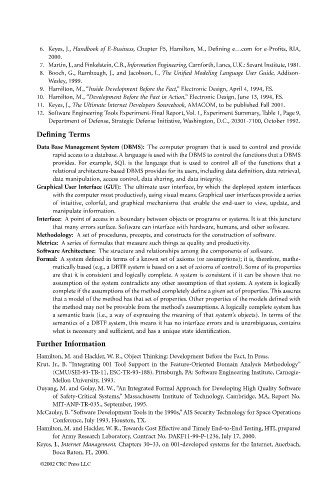Page 1222 - The Mechatronics Handbook
P. 1222
0066_frame_C49.fm Page 17 Thursday, January 10, 2002 5:05 PM
6. Keyes, J., Handbook of E-Business, Chapter F5, Hamilton, M., Defining e…com for e-Profits, RIA,
2000.
7. Martin, J., and Finkelstein, C.B., Information Engineering, Carnforth, Lancs, U.K.: Savant Institute, 1981.
8. Booch, G., Rumbaugh, J., and Jacobson, I., The Unified Modeling Language User Guide, Addison-
Wesley, 1999.
9. Hamilton, M., “Inside Development Before the Fact,” Electronic Design, April 4, 1994, ES.
10. Hamilton, M., “Development Before the Fact in Action,” Electronic Design, June 13, 1994, ES.
11. Keyes, J., The Ultimate Internet Developers Sourcebook, AMACOM, to be published Fall 2001.
12. Software Engineering Tools Experiment-Final Report, Vol. 1, Experiment Summary, Table 1, Page 9,
Department of Defense, Strategic Defense Initiative, Washington, D.C., 20301-7100, October 1992.
Defining Terms
Data Base Management System (DBMS): The computer program that is used to control and provide
rapid access to a database. A language is used with the DBMS to control the functions that a DBMS
provides. For example, SQL is the language that is used to control all of the functions that a
relational architecture-based DBMS provides for its users, including data definition, data retrieval,
data manipulation, access control, data sharing, and data integrity.
Graphical User Interface (GUI): The ultimate user interface, by which the deployed system interfaces
with the computer most productively, using visual means. Graphical user interfaces provide a series
of intuitive, colorful, and graphical mechanisms that enable the end-user to view, update, and
manipulate information.
Interface: A point of access in a boundary between objects or programs or systems. It is at this juncture
that many errors surface. Software can interface with hardware, humans, and other software.
Methodology: A set of procedures, precepts, and constructs for the construction of software.
Metrics: A series of formulas that measure such things as quality and productivity.
Software Architecture: The structure and relationships among the components of software.
Formal: A system defined in terms of a known set of axioms (or assumptions); it is, therefore, mathe-
matically based (e.g., a DBTF system is based on a set of axioms of control). Some of its properties
are that it is consistent and logically complete. A system is consistent if it can be shown that no
assumption of the system contradicts any other assumption of that system. A system is logically
complete if the assumptions of the method completely define a given set of properties. This assures
that a model of the method has that set of properties. Other properties of the models defined with
the method may not be provable from the method’s assumptions. A logically complete system has
a semantic basis (i.e., a way of expressing the meaning of that system’s objects). In terms of the
semantics of a DBTF system, this means it has no interface errors and is unambiguous, contains
what is necessary and sufficient, and has a unique state identification.
Further Information
Hamilton, M. and Hackler, W. R., Object Thinking: Development Before the Fact, In Press.
Krut, Jr., B. “Integrating 001 Tool Support in the Feature-Oriented Domain Analysis Methodology”
(CMU/SEI-93-TR-11, ESC-TR-93-188). Pittsburgh, PA: Software Engineering Institute, Carnegie-
Mellon University, 1993.
Ouyang, M. and Golay, M. W., “An Integrated Formal Approach for Developing High Quality Software
of Safety-Critical Systems,” Massachusetts Institute of Technology, Cambridge, MA, Report No.
MIT-ANP-TR-035., September, 1995.
McCauley, B. “Software Development Tools in the 1990s,” AIS Security Technology for Space Operations
Conference, July 1993, Houston, TX.
Hamilton, M. and Hackler, W. R., Towards Cost Effective and Timely End-to-End Testing, HTI, prepared
for Army Research Laboratory, Contract No. DAKF11-99-P-1236, July 17, 2000.
Keyes, J., Internet Management, Chapters 30–33, on 001-developed systems for the Internet, Auerbach,
Boca Raton, FL, 2000.
©2002 CRC Press LLC

